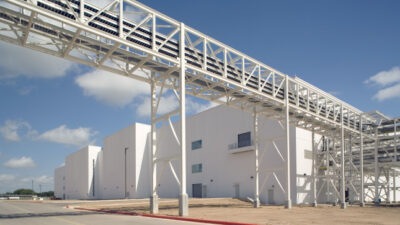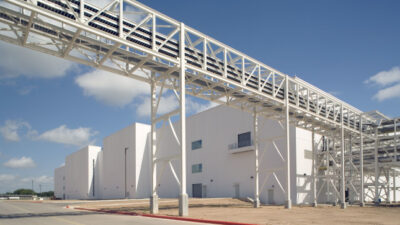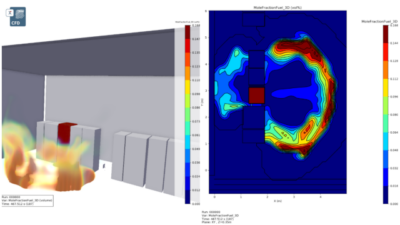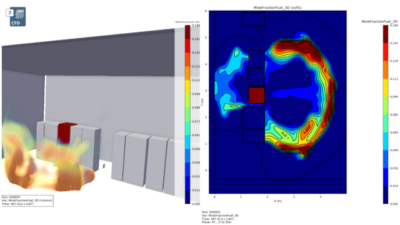During the 2003 summer blackout, which left large parts of the Midwest and East Coast in the dark, hundreds of health-care facilities were affected.
Like many of its neighbors, one Midwest hospital lost both primary and alternate power. To add insult to injury, the local utility soon after informed the hospital that due to local growth, it would have to start charging a hefty fee for alternate power service. The hospital decided it was time to back up its entire campus with emergency gensets.
Power events are often the catalyst that finally motivates a health-care facility to address neglected maintenance and needed upgrades. But at the same time, these projects come with a whole slew of challenges.
Meeting The Challenge
Once a health-care facility determines it’s time to upgrade, either as a result of unpleasant downtime during an outage or to meet the needs of an expansion, the first question is whether the utility can provide the needed power.
“Because of deregulation, utilities don’t necessarily have capacity for full backup, because they are not upgrading their distribution systems,” explains Gerald Petric, P.E., vice president, Korda/Nemeth Engineering, Columbus.
Jim Hannon, P.E., electrical engineering, Burt Hill Kosar Rittellmann Assocs., Butler, Pa., adds that if the utility grid capacity is borderline, the utility will most likely charge the hospital generously for additional power.
But even without adding power capacity, one should approach the utility to request proper maintenance on its end. “You may not necessarily get them to do full servicing,” says Paul M. McGurl, a project manager with Bala Consulting Engineer’s health-care division, Wynnewood, Pa., “but if they have a knowledgeable client who asks for documentation to explain power fluctuations, [the utility] tend to give that client more attention.”
For example, McGurl mentions a case where a utility was doing some reconfiguration work at a substation and accidentally dropped a phase. All kinds of equipment blew out downstream, causing some damage to a hospital’s systems. But because the hospital was able to trace the event through its metering system, the utility couldn’t deny what happened.
But back to the issue of power system upgrade. The next step is avoiding the most common error—not taking into account future growth. “The only sure thing about hospitals is that they will grow … often much faster than they even realize,” says Gerald Versluys, P.E., an electrical project engineer at TLC Engineering for Architecture’s Jacksonville, Fla. office. “A design that doesn’t anticipate a large addition within five years is a mistake. Often we see major renovations occurring to health-care facilities within two years of completion.”
Hospitals need a long-term master plan, but many don’t have one. “This way you can put in a system that can grow as the facility grows,” says Phil Granitz, P.E., principal, electrical engineering, HarleyEllis, Southfield, Mich.
Similarly, consultants stress the importance of building flexibility into the power system so that the owner will have more options.
For example, Dwayne Miller, P.E., principal, JBA Consulting Engineers, Las Vegas, advises including a spare breaker and conduit for temporary or back-feed use. “At the initial onset, this is not a big cost item, and if you ever need them, they pay for themselves many times over,” he posits.
Operational and maintenance issues are also common problems with emergency power systems. “We can do a wonderful job designing all this high-tech stuff, but who’s going to run it?” asks Ed Lobnitz, P.E., TLC Engineering for Architecture’s former CEO. “Generally, operators have little knowledge of the technical aspects of equipment, such as paralleling switchgear, and may have to hire more staff to run the equipment.”
At the same time, however, as McGurl points out, hospitals are facilities accredited by the Joint Commission on Accreditation of Healthcare Organizations, which are surveyed every three years and are required to maintain a certain skill level on staff, as well as regular maintenance and testing.
The competence of staff notwithstanding, equipment performance is the real key, and equipment must be tested. For example, generators must be tested for full power-loss conditions, not just simply run on a partial load to fulfill monthly testing requirements. And in this way, the medical staff is also involved and will be much better prepared if and when a real power event occurs.
“Sometimes people just run generators [during testing] and don’t put a load on them. Over the years, more things are added onto the emergency power systems, and it ends up exceeding capacity,” warns Joe Trusk, P.E., chief electrical engineer for SmithGroup’s Health Studio, Detroit.
Or, in an effort to protect sensitive equipment from voltage spikes or surges, hospitals will turn these systems off prior to generator testing. But again, it’s not a true test, says Michael Pearson, P.E., senior electrical engineer, DLR Group, Phoenix. To get around this, Pearson advises putting filters on this kind of equipment, but keeping the devices operational during backup power testing.
With regard to testing new equipment, Petric recommends clearly spelling out testing procedures in the specs and allowing enough time for such testing before going online.
Randy Leech, P.E., RCDD, senior electrical engineer, HSMM, Roanoke, Va., concurs. “We could be rewiring a switchboard on a Saturday night, in a hurry to get back online. Naturally, this takes extra effort and coordination.”
Leech also points out the need for consistency and organization with regards to labeling and documentation. “Sometimes people deviate from standards, using different labeling nomenclature. If work is done on part of a system, it needs to remain part of a comprehensive system.”
JBA’s Miller agrees, noting that in many cases, hospitals will not have current “as-built” information, so the engineers will have to take apart the system to see how it was constructed.
For the sake of organization, Lobnitz recommends using a tool such as CAD-interactive software to enable an operator to quickly locate all electrical equipment in the facility, as well as putting effort into keeping hospital equipment drawings organized.
Staying Grounded
Another important coordination item is grounding and ground-fault protection. “Because hospitals are often built in phases, they sometimes connect to different distribution systems that don’t share the same ground point, and could even be different structures,” notes Pearson. “It can be challenging to expand the grounding system with low impedance and high frequency.”
Also, once a grounding system is established, operators must take care to maintain it. “People tend to take the grounding system for granted, putting it in and forgetting about it,” says Pearson. “An electrician working on the system needs to keep the neutrals and grounding conductors connected to the proper buses.”
Hospitals electrical loads are constantly changing, and it’s essential to be able to isolate a fault at its lowest point. “You don’t want a fan to go to ground and shut down a wing of the hospital,” cautions Pearson.
He recommends at least two levels of ground fault protection, if not more, even though it can be costly.
“Of course, it’s not economical to put ground fault protection on every circuit, but we recommend more tiers than what the code requires,” he says. (See “Selective Circuit Breaker Coordination,” at left.)
Similarly, Miller argues that it’s necessary to segregate sensitive and non-sensitive loads to maintain power quality, so they try to do an extensive failure analysis. “But there’s only so much you can do because it costs money to build in each level of redundancy,” he explains.
Where’s The Money?
But even though electrical systems are critical for hospitals, they often prefer to invest their dollars in clinical care.
“Power upgrades have always been an afterthought because they are not revenue generating,” says Petric. Furthermore, it can be difficult to locate space for housing electrical equipment—hospital real estate is valuable.
In other cases, administrators fail to recognize all the costs involved in such endeavors, and ultimately, projects get shelved due to a lack of planning or budgeting, according to Jeff Maitlen, P.E., an electrical project engineer at TLC’s Tallahassee office.
Finally, even when adequate funding is appropriated, adds Scott Kesler, P.E., director of electrical engineering, OWP&P, Chicago, it often comes through as fixed dollars per year. “As a result, the work has to be staged according to when the money comes through, which can be difficult to schedule,” he explains.
War Stories
But despite the challenges, power events can quickly motivate hospitals to upgrade. For example, during the summer 2003 blackout, some hospitals realized that even though code doesn’t require cooling systems to be on emergency power, “no modern health-care facility can operate in the summertime for an extended period of time without cooling,” says Granitz.
Prior to the blackout a number of hospitals reasoned that they could simply evacuate patients to neighboring hospitals. However, the blackout was so widespread that there were none available—everyone was in the dark.
“I received a panic phone call from one of our [Detroit] clients while I was on vacation to send a team of engineers to show the hospital how to reduce energy, cut back and make temporary connections,” recalls Granitz.
Then, when the lights came back on, Granitz’s team had to be on hand for another client with six utility lines in order to assist with phasing systems back online to avoid overloading the utility’s as well as the hospital’s electrical system.
Similar to the effects of the 2003 blackout, last summer’s hurricanes in the southern U.S. exposed many weaknesses in health-care power systems.
“Even though one hospital in Florida had sealed its conduits, its system couldn’t handle the pressure from flooding,” notes Versluys. “When the electrical room fills up with water, you’re done. Nothing works anymore.”
Consequently, Versluys cautions, the code minimum is simply not acceptable in most places, because it leaves health-care facilities vulnerable.
Versluys’ colleague, Daric Hess, P.E., an electrical project engineer with TLC’s Orlando office, similarly notes that in the aftermath of the hurricanes, many facilities realized that after three days without power, any money saved through value engineering quickly went out the window when they had to come up with other solutions.
On a brighter note, TLC’s Lobnitz shares a success story about one Naples, Fla. hospital that had the foresight to relocate its power equipment to the second floor. “Even though it was unbelievably expensive, they weren’t affected by the hurricanes.”
Similarly, another TLC client on the Florida coast is developing a hardened shelter within its facility. “During the highest category storms, when the first floor of the facility could be flooded and the windows blown out, they will withdraw to an interior space that will have dedicated heating, power and communications. The rest of the hospital will be shut down to prevent short-circuiting and other catastrophic infrastructure failures,” relates Versluys.
Back up north, OWP&P’s Kesler brings another example of a weather-motivated upgrade, where a northwest Indiana hospital—with its main power feed coming in through overhead utility lines—consistently suffered from outages as a result of snow. Eventually, the facility decided to bring in two new utility lines underground, in addition to installing new switchgear and a new distribution system.
Another one of Kesler’s clients, a Phoenix hospital that had been negligent in maintaining its electrical systems, experienced a circuit breaker failure on the main service, killing power to the entire facility. “We had to scramble to repair the existing service board over the weekend to get them back up and running,” he recalls. “Shortly afterwards, they approved an electrical service upgrade, replacing the entire switchboard and putting in a redundant feed from the utility.”
In addition, Kesler shares a story about a concerned physician who experienced power going on and off several times during a catheterization lab procedure—while the hospital generator was being tested in response to a problem with the system. As a result of bringing his concerns to senior management, a power retrofit came about.
Some engineers probably won’t be too surprised about such a chain of events. “Liability is a big issue. It doesn’t get any more serious than a patient undergoing surgery and the power going out,” says Miller.
Of course, outside of power events, the most common motivation for electrical upgrade is a health-care facility’s desire to expand its services.
“You have to have the electrical infrastructure as everything takes power to run,” Burt Hill’s Hannon stresses. “The electrical utility is often taken for granted because it is behind the scenes, but everything relies on it.”
Consequently, Hannon says, power upgrades are a very common retrofit item. “There isn’t a health-care project we’re doing that doesn’t involve it.”
What’s New?
Some newer technologies slowly making their way into hospital power systems are flywheel UPS and microturbines, with fuel cells not too far behind.
“We’re starting to put more and more flywheel UPS in,” notes Hannon. “Clients really like this because there’s minimal maintenance, as you only have to check the bearings every two years, whereas with UPS batteries, they should be checked every month.”
Even though flywheel is a slightly more expensive technology, Petric predicts that due to its low maintenance advantage—not to mention the fact that it’s much more lightweight—batteries will eventually become obsolete.
Similarly, fuel cells are another low maintenance option because the technology, which is simply a chemical reaction, doesn’t involve combustion, noise or moving parts. Of course, the first cost has to come down before it becomes a serious consideration.
On the topic of microturbines, the technology is just beginning to break into the health-care market. Although highly energy-efficient, it can only generate a limited amount of power at this point, according to Kesler. Thus, he feels it’s not an option for a larger buildings. However, for a clinic or medical office building, it can be a good fit.
Also, energy-efficient transformers can help owners realize significant savings with efficiencies reaching the high 90s, notes Miller. In general, it’s important to note that hospitals aren’t too interested in trying out cutting edge technology.
“Most of the time, when you say the word ‘new,’ they don’t want it, as they don’t want to be experimented on,” says TLC’s Versluys.
“Health-care facilities don’t want a system that hasn’t been out there and tested in the market for at least three to five years,” explains TLC’s Hess. Decision makers want to speak to facility managers at other hospitals who have installed the technologically.
A Personal Guide
But regardless of the technology, an institution has to value quality and reliability enough to allocate proper resources toward achieving a successful power retrofit. And this, of course, requires bringing an experienced and knowledge engineering consultant on board as a valuable guide.
In sum, Trusk characterizes main power upgrade considerations as: reliability, constructability, maintainability and affordability.
Selective Circuit Breaker Coordination
Electrical systems in hospitals are required to have a coordinated tripping scheme for in-building ground faults. Properly coordinated systems assure that the smallest overcurrent protection device trips whenever there is a ground fault on the system. This minimizes the possibility of a “blackout” occurring from a minor fault.
A novice electrical designer often falls into the trap of expanding a service enough to serve the loads while ignoring the breaker-to-breaker ratios necessary for a fully coordinated overcurrent protection scheme. This can become critically important with the increasing number of large ampacity overcurrent devices serving critical loads.
For example, I recently had a surgical suite that had a 700-amp, 480-volt circuit breaker serving an equipment load. The only way we could coordinate this circuit breaker with the existing service was to route the feeders back to the main service entrance even though the load was less than 100 VA.
The Mysterious Breakdown of Imaging Equipment
Imaging equipment, although crucial to diagnosing serious medical conditions, is very expensive technology— and consequently, often challenging to maintain.
In fact, in J. Michael Pearson’s experience working with the equipment, he’s witnessed “an extraordinary frequency of breakdowns.”
Over the years, Pearson, a P.E. and senior electrical engineer with the DLR Group in Phoenix, has identified the main problem as resonance, which eventually leads to extensive servicing and the need for replacement parts.
“Resonance, in this context, is extremely complex, being described mathematically by the dynamic impedance of both source and load, and most engineers lack the tools with which to address it,” he explains.
The good news is that Pearson was able to develop a tuned power filter which has proven, in his experience, to significantly reduce the number of imaging equipment breakdowns and save the hospital 25% in maintenance expenses, sometimes even as much as 50% to 75%. The not so good news is that equipment manufacturers haven’t been too fond of this technological solution as it has affected their bottom line in the sale of service contracts and replacement parts, claims Pearson.
In some cases, Pearson says, he’s actually witnessed manufacturers refusing to give a hospital a service contract if they installed such a filter, claiming that it would have an adverse effect on the imaging equipment.
Reflecting upon the situation, Pearson suggests, “Astute observers will point out that certain industry players see more financial advantage in treating the symptoms than in curing the disease. There would be much less at stake here if we were talking only about money.
“It is the negative impact on people, however, that should motivate us all to do better. Thus, we have a classic tug-of-war between commerce and ethics.”
Diesel vs. Natural Gas
When it comes to on-site generation, owners of health-care facilities must decide between diesel fuel and natural gas. Well, not necessarily.
The truth is that in many municipalities, natural gas is not deemed to be reliable enough. However, in some cases, it is possible to lobby the authorities having jurisdiction to convince them to recognize natural gas a reliable source of power, according to Scott Kesler, P.E., director of electrical engineering, OWP&P, Chicago.
Also, as Joe Trusk, P.E., chief electrical engineer for SmithGroup’s Health Studio, Detroit, states, “If you’re a state institution, you have your own authority and can choose to go with natural gas.”
So assuming one does have a choice, what are the main pros and cons?
“With natural gas, you don’t have to worry about a fuel tank or keeping the fuel fresh. Also, there are reduced emissions. However, the bigger natural gas units cost up to three times as much as the diesel units.” says Jim Hannon, P.E., electrical engineering, Burt Hill Kosar Rittellmann Assoc., Butler, Pa.



